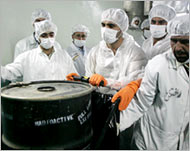Iran: Scale of nuclear work is small
After a two-year break, Iran has resumed nuclear-fuel enrichment on what it called a small scale, stoking a diplomatic showdown with the West.

On Tuesday, Iran announced it was deferring until next week talks on a Russian proposal to defuse the standoff.
But it gave no sign that it was ready to stop purifying uranium on its own soil.
Officials close to the International Atomic Energy Agency (IAEA) said on Tuesday that inspectors observed Iranian scientists putting uranium hexafluoride (UF6) gas into a small number of centrifuges.
The centrifuge machines can convert uranium into fuel for nuclear reactors or, if enriched to high levels, warheads.
Small scale
Gholamreza Aghazadeh, director of Iran’s atomic programme, was quoted by ISNA students news agency as saying the centrifuge work re-launched at the Natanz pilot fuel enrichment plant was on a “small and laboratory scale”.
“Injecting gas into one or a few centrifuges could not be termed enrichment.”
|
“Injecting gas into one or a few centrifuges could not be termed enrichment” Gholamreza Aghazadeh, |
Earlier in the day, Iran said no actual uranium enrichment work had begun but that preliminary work was under way to prepare centrifuges for production after the extended suspension, maintained under Western pressure.
The West suspects Iran of trying to develop atom bombs under cover of a civilian atomic energy drive and persuaded the IAEA’s governing board last week to report Iran to the UN Security Council for possible action, which could include sanctions.
Electricity generation
Iran denies any military intent in its nuclear work, saying it is designed solely to generate electricity for its economy.
Tehran believes the Western-backed push to control its nuclear programme will fade because of international dependence on Iranian oil and gas exports.
An official close to the IAEA said the amount of UF6 being introduced into centrifuges “was of absolutely no use” in making weapons-grade fuel and that the new work was “an early testing phase en route to mastering the technology”.
He said Iran remained at least months away from reactivating an entire cascade of 164 centrifuges. Another diplomat dealing with the IAEA said Tehran had components for another 1000-1500 centrifuges in storage for future assembly.
The official said: “They face technical difficulties merely getting the 164 back on line.”
More centrifuges
Nuclear analysts say about 1500 centrifuges would be needed for Iran to manufacture the minimum 20kg of highly enriched uranium needed for one crude warhead.
 |
|
Iran aims to have 50,000 centri- |
Uranium hexafluoride typically must be enriched to 5% purity for nuclear reactor fuel and to around 90% to set off the chain reaction required for a bomb.
Iranian officials said while “industrial-scale” enrichment at Natanz was some way off, preliminary work to revive the pilot project had begun, intensifying international concern over Iran‘s nuclear ambitions.
Iran says it aims eventually to have 50,000 centrifuges running to provide fuel for its first nuclear reactor at Bushehr nearing completion by Russian builders.
Iran had vowed to resume uranium enrichment and halt short-notice IAEA inspections in retaliation for the IAEA vote.
Russian proposal
Russia has offered to enrich uranium on Iran‘s behalf in a compromise designed to allay world fears that the Iranians might siphon nuclear material off into underground bomb-making.
Iranian nuclear negotiator Javad Vaeedi said talks on the proposal would now start in Moscow on 20 February.
He said: “We still want to reach a formula to prove that we will not divert uranium enriched on Iranian soil.”
Iran has undercut Moscow‘s proposal by announcing it was exercising its right to resume uranium enrichment at Natanz.